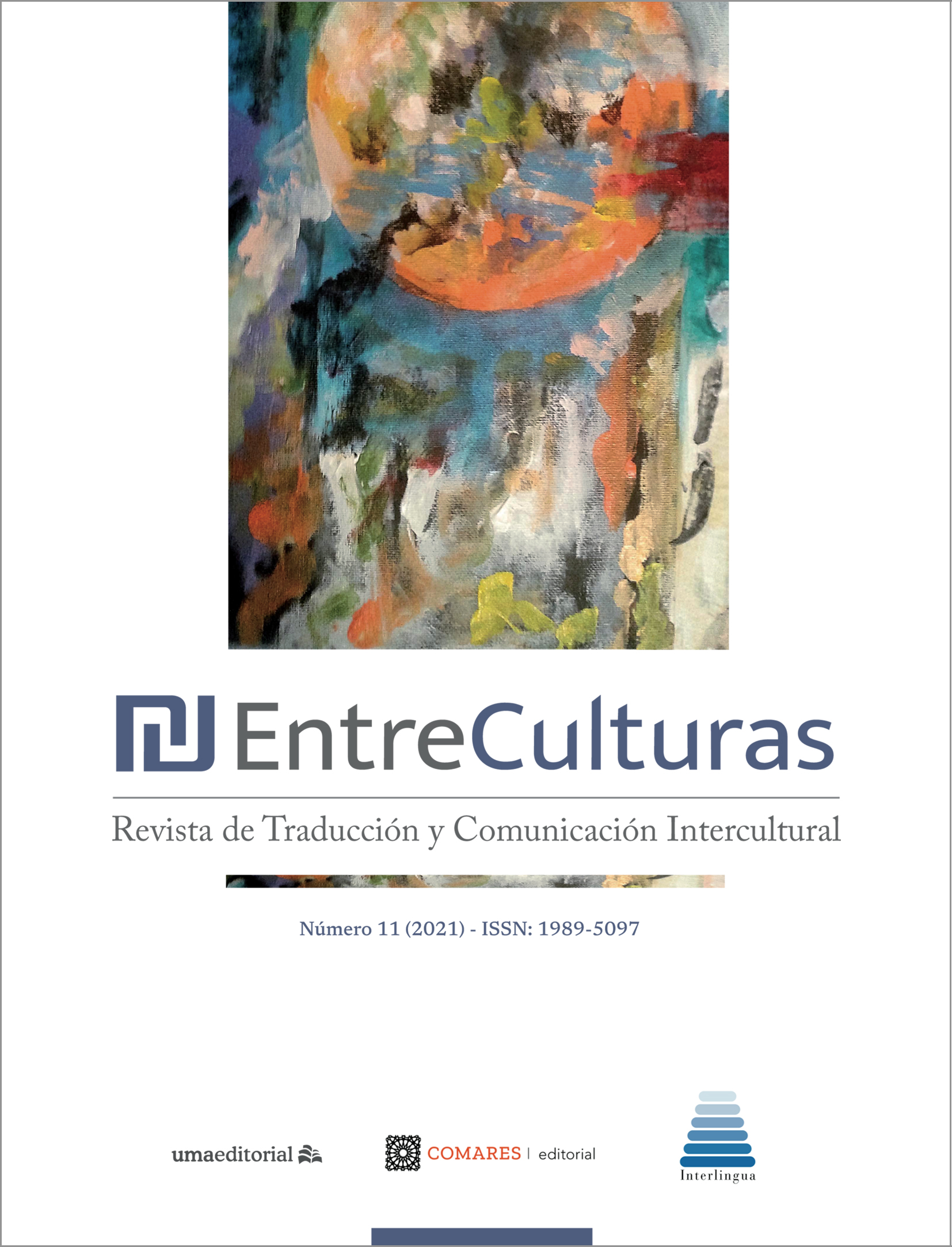Sociolinguistic Communities
DOI:
https://doi.org/10.24310/Entreculturasertci.v1i11.12099Keywords:
Sociolinguistics, communities, taxonomyAbstract
The present work proposes a taxonomy to try to give an account of a reality, as complex as that of the communities around which the sociolinguistic dynamism is organized. This proposal is based on two groups of criteria: sociological and linguistic, in accordance with the model from which it starts. These parameters are distributed through three levels of sociolinguistic complexity (micro, mesoand macro-sociolinguistic). From this combination nine classes of sociolinguistic communities emerge, from the speech communities (situated at the basic microsociolinguistic level) to the speech communities (at the extended macrosociolinguistic level).
Downloads
Metrics
References
Bloomfield, L. (1933). Language. Nueva York, Holt
Bollinger, D. (1968). Aspects of Language. Nueva York, Harcourt Brace Jovanovich, 1975.
Calvet, L. J. (1999). Pour une e?cologie des langues du monde. Pari?s, Plon.
Cerný, J. (1996). Historia de la lingüística. Cáceres, Universidad de Extremadura, 1998.
De Saussure, F. (1916). Curso de lingüística general. Buenos Aires, Losada. Edc. Esp. De A. Alonso, 1945.
Dorian, N. C. (1982). “Defining the speech community to include its working margins” en S. Romaine (ed.), Sociolinguistic variation in speech communities. Londres, Arnold, 25-33.
Fishman, J. A. (1972). Sociología del lenguaje. Madrid: Cátedra, 1988.
Gal, S. (1983). Comment on L. B. Breitborde's "Levels of analysis in sociolinguistic explanation: Bilingual code switching, social relations, and domain theory." International Journal of the Sociology of Language, 39: 63-72.
García Marcos, F. (1999). Fundamentos críticos de sociolingüística. Almería, Universidad de Almería.
García Marcos, F. (2015). Sociolingüística. Madrid: Síntesis.
García Marcos, F. (2020). Variación y cambio sociolingüísticos en tiempo real. El español de la Costa Granadina (1987-2017). Jaén, Universidad de Jaén. En prensa.
Grassi, C.; A. A. Sobrero y T. Telmon. (1997). Fondamenti di dialettologia italiana. Roma-Bari, Laterza.
Gumperz, J. (1962). “Types of linguistic community” en Anthropological linguistics, 44: 28-40.
Gumperz, J. (1968). “The speech community” en International encyclopaedia of the social sciences. Nueva York, McMillan, 381-6.
Guy, G. R. (1988). “Language and social class” en Newmeyer, F. (ed.) Linguistics: The Cambridge Survey, 4. Cambridge: Cambridge University Press, 37-63.
Hockett, Ch. F. (1958). A Course in Modern Linguistics. Nueva York, McMillan.
Hudson, R. A. (1980). La sociolingüística. Barcelona, Anagrama, 1982.
Hymes, D. (1974) Foundations in Sociolinguistics: An Ethnographic Approach .Filadelfia, Univ. of Pennsylvania Press.
Kerswill, P. (1993). “Rural dialect speakers in an urban speech community: The role of dialect contact in defining a sociolinguistic concept” en International Journal ofApplied Linguistics, 3: 1.33-56.
Labov, W. (1972). Sociolinguistic patterns. Filadelfia: University of Pennsylvania Press.
Le Page, R. B. (1968). “Problems of description in multilingual communities” en Transactions of the Philological Society, 67 (1), 189-212.
López Morales, H. (1989). Sociolingüística. Madrid, Gredos.
Lyons, J. (ed.) (1970). New directions in linguistics. Londres, Penguin.
Marti?nez T. A e I. Taquechel (1994): Glosario de promoción y animación socio-cultural en el trabajo de comunidades. Santiago de Cuba, Universidad de Oriente.
Milroy, L. (1980). Language and social networks. Oxford, Blackwell.
Moreno Ferna?ndez, F. (1998). Principios de sociolingu?i?stica y sociologi?a del lenguaje. Barcelona, Ariel.
Parodi, C. y O. Santa Ana. 1997. “Tipología de comunidades de habla: del español rural al estándar” en Nueva Revista de Filología Hispánica, 45, 2: 305-320.
Pisani, A. E. M. (1987). La variazione linguistica. Causalismo e probabilismo in sociolinguistica. Milán, Franco Angeli.
Raiter, A. (2001). Representaciones Sociales. Buenos Aires, EUDEBA.
Romaine, S. (1982),” What is a speech community?” en Romaine (ed.) Sociolinguistic variation in speech communities. Londres, Arnold, 13-24.
Renzi., L. (1985).Nuova introduzione alla filologia romanza. Bolonia, Il Mulino.
Rona, J. P. (1973). “Normas locales, regionales, nacionales y universales en la América española” en Nueva Revista de Filología Hispánica 22: 310-21.
Socarra?s, E. (2004): “Participación, cultura y comunidad” en Linares Fleites, C., P. E. Moras Puig y B. Rivero Baxter (compiladores). La participación. Diálogo y debate en el contexto cubano. La Habana. Centro de Investigación y Desarrollo de la cultura Cubana Juan Marinello, 173–180.
Violich, F. (1971) Desarrollo de la comunidad y el proceso de planificación urbana de América Latina. Universidad de California.
Zhan, Ch. (2013). “Speech Community and SLA” en Journal of Language Teaching and Research, 4, 6: 1327-1331.
Downloads
Published
How to Cite
Issue
Section
License
All contents published in Entre culturas. Revista de traducción y comunicación intercultural are protected under the Creative Commons Attribution-NonCommercial-ShareAlike 4.0 International (CC BY-NC-SA 4.0) license. All about this license is available in the following link: <http://creativecommons.org/licenses/by-nc-sa/4.0>
Users can copy, use, redistribute, share and exhibit publicly as long as:
- The original source and authorship of the material are cited (Journal, Publisher and URL of the work).
- It is not used for comercial purposes.
- The existence of the license and its especifications are mentioned.
There are two sets of authors’ rights: moral and property rights. Moral rights are perpetual prerogatives, unrenounceable, not-transferable, unalienable, imprescriptible and inembargable. According to authors’ rights legislation, Entreculturas. Revista de traducción y comunicación intercultural recognizes and respects authors moral rights, as well as the ownership of property rights, which will be transferred to University of Malaga in open access. The property rights are referred to the benefits that are gained by the use or the dissemination of works. Entreculturas. Revista de traducción y comunicación intercultural is published in an open access form and it is exclusively licenced by any means for doing or authorising distribution, dissemination, reproduction, , adaptation, translation or arrangement of works.
Authors are responsable for obtaining the necessary permission to use copyrighted images.





7.png)
